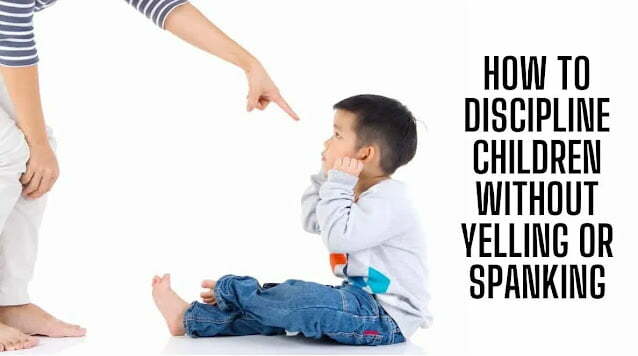When it comes to parenting, discipline is a crucial aspect of raising happy, healthy children. But it’s important to note that discipline doesn’t have to involve yelling or spanking. In fact, those types of disciplinary measures can have negative effects on children’s development and well-being.
So, if you’re looking for alternative methods of disciplining children without resorting to yelling or spanking, you’ve come to the right place! In this blog post, we’ll explore some effective ways to discipline your child that are both gentle and effective. But first, let’s take a closer look at the importance of disciplining children and why yelling or spanking isn’t the way to go.
Why Discipline is Important
Discipline is all about teaching children appropriate behavior and helping them learn how to make good choices. It’s a crucial part of their development, as it helps them develop self-control, respect for others, and a sense of responsibility.
Discipline is an essential component of parenting as it helps children learn how to regulate their behavior, follow rules, and make better decisions. By setting clear boundaries and expectations, parents can create a safe and structured environment that fosters their child’s growth and development.
Without discipline, children may struggle with boundaries and consequences, which can lead to behavior problems and difficulties in school and social settings.
The Difference between Punishment and Discipline
While punishment and discipline may seem interchangeable, they have different meanings and outcomes. Punishment is about imposing consequences for negative behavior, often through negative reinforcement. On the other hand, discipline focuses on teaching children appropriate behavior and positive reinforcement to reinforce positive actions.
The Negative Effects of Yelling or Spanking
While yelling or spanking may seem like a quick fix to discipline problems, they can actually have negative effects on children’s emotional and mental health. Some of the negative effects of yelling or spanking include:
- Increased aggression and defiance
- Decreased self-esteem and confidence
- Higher risk of anxiety and depression
- Damaged parent-child relationships
It’s important to note that discipline should never involve physical or emotional harm to your child. Instead, it should be focused on teaching and guiding your child toward positive behavior.
The Importance of Positive Reinforcement
Positive reinforcement is an essential aspect of effective discipline. It involves acknowledging and rewarding positive behavior, such as showing kindness, following rules, or being honest. By providing positive feedback and rewards, parents can encourage their child’s good behavior and create a positive environment.
Some ways to incorporate positive reinforcement in your parenting include:
- Praising your child for their accomplishments or good behavior
- Offering incentives, such as a special treat or activity, for achieving a goal
- Giving your child increased responsibility, such as allowing them to make choices and decisions
By using positive reinforcement, you can help your child develop a positive self-image, boost their self-esteem, and encourage them to make positive choices.
Positive Parenting Strategies
Now that we have a better understanding of the discipline, let’s discuss some positive parenting strategies that can help you discipline your child without yelling or spanking.
1. Setting Rules and Boundaries
Setting clear rules and boundaries is an essential aspect of positive parenting. It helps children understand what is expected of them and what behaviors are acceptable or not. When setting rules, make sure they are clear, age-appropriate, and consistent. Some tips to keep in mind include:
- Involve your child in the rule-setting process, so they feel included and invested in the process
- Be consistent in enforcing rules and consequences, so your child knows what to expect
- Use positive language to communicate the rules and boundaries, focusing on what your child should do rather than what they shouldn’t
2. Using Positive Language
Using positive language is another effective way to communicate with your child and promote positive behavior. Positive language focuses on what your child should do, rather than what they shouldn’t. Some examples include:
- Instead of saying “Don’t hit your sister,” say “Use kind words and gentle touches with your sister.”
- Instead of saying “Stop running,” say “Walk slowly and carefully.”
Using positive language helps your child feel encouraged and empowered to make good choices and reinforces positive behavior.
3. Active Listening and Empathy
Active listening and empathy are essential components of positive parenting. When disciplining your child, it’s important to listen to their concerns, thoughts, and feelings, and to show empathy for their situation. This can help your child feel heard and understood and create a more positive environment for discipline. Some tips to help you listen actively and show empathy include:
- Listen to your child without interrupting or judging
- Show empathy by acknowledging your child’s feelings and perspective
- Try to put yourself in your child’s shoes and understand their point of view
By using active listening and empathy, you can build a stronger relationship with your child and create a more positive environment for discipline.
Reducing the Need for Discipline
When it comes to disciplining children, prevention is always better than cure. Here are some ways to reduce the need for discipline:
1. Establish Routines and Schedules
Establishing routines and schedules can help children feel more secure and give them a sense of predictability. When children know what to expect, they are less likely to act out. Some tips for establishing routines and schedules include:
- Creating a consistent daily routine for meals, playtime, and bedtime
- Setting regular schedules for activities such as homework, playdates, and extracurricular activities
- Preparing children for any changes in their routine or schedule ahead of time
2. Use Natural Consequences
Using natural consequences can be an effective way to teach children about cause and effect without resorting to punishment. Some examples of natural consequences include:
- If a child forgets to bring their homework to school, they will receive a lower grade
- If a child refuses to eat their dinner, they will be hungry later
It’s important to note that natural consequences should not be harmful or dangerous.
3. Be a Good Role Model
Children learn by example, so being a good role model is essential. Some tips for being a good role model include:
- Modeling positive behaviors such as kindness, respect, and responsibility
- Showing empathy and understanding when children make mistakes
- Avoiding yelling, spanking, or other forms of physical punishment
By being a good role model, you can help your children learn how to behave appropriately without the need for discipline.
4. Teach Problem-Solving Skills
Teaching problem-solving skills can also help reduce the need for discipline. When children know how to solve problems on their own, they are less likely to rely on adults to solve their problems for them. Some tips for teaching problem-solving skills include:
- Encouraging children to brainstorm solutions to their own problems
- Helping children identify the pros and cons of each solution
- Letting children choose the best solution for themselves
5. Use Positive Reinforcement
Positive reinforcement is a powerful tool for encouraging good behavior in children. Some examples of positive reinforcement include:
- Praising children for their good behavior
- Offering rewards for meeting specific goals
- Using a sticker chart or other visual aid to track progress
It’s important to remember that positive reinforcement should be used in moderation and not be the sole focus of discipline.
Conclusion
In conclusion, disciplining children is an essential part of their development, but it is important to do it without resorting to yelling or spanking. These methods can have negative effects on a child’s emotional and mental well-being. Instead, parents can use positive discipline techniques that foster healthy communication and relationships.
Some key takeaways for disciplining children without yelling or spanking include:
- Understanding the need for discipline and the difference between punishment and discipline
- Using positive reinforcement and positive language when communicating with children
- Practicing active listening and empathy when disciplining children
- Reducing the need for discipline by establishing routines and schedules, using natural consequences to teach children, and being a good role model
By using these positive parenting strategies, parents can help their children develop self-discipline and problem-solving skills, build strong relationships, and foster healthy emotional and mental development.
It may take some practice and patience, but the benefits of positive discipline are well worth the effort. So, let’s commit to disciplining children without yelling or spanking and providing a positive and nurturing environment for their growth and development.












